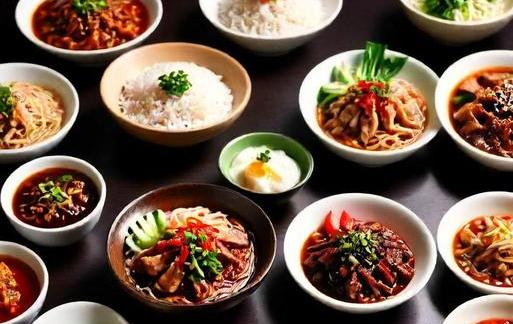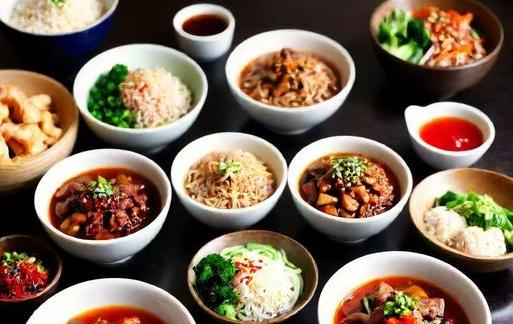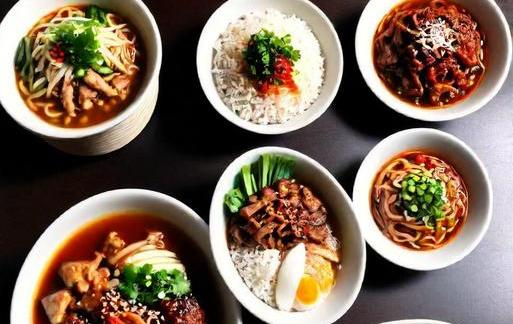- You are here:
- Home »
- Food
- » [REVEALED] Asian Foods That Start With K
[REVEALED] Asian Foods That Start With K
Note: This page contains affiliate links.
As an Amazon Associate, I earn from qualifying purchases when you click on the link, but you are not charged extra.
Asian cuisine is a diverse and rich tapestry of flavors, textures, and aromas that captivate the senses. From the spicy delights of South Asia to the delicate flavors of East Asia, each region contributes unique dishes that have become culinary treasures. In this exploration of Asian cuisine, we turn our attention to foods that start with the letter “K”. From street food to elaborate dishes served in fine dining establishments, the variety is vast. Let’s embark on a gastronomic journey as we delve into the world of Asian foods that start with the letter “K”.
Contents
List Of Asian Foods That Start With K

1. Kimchi (Korea)
Description:
Kimchi is a staple in Korean cuisine, a fermented dish made primarily from napa cabbage and Korean radishes. The vegetables are seasoned with a blend of chili peppers, garlic, ginger, and other spices before undergoing a fermentation process. This results in a tangy, spicy, and slightly effervescent side dish that is not only delicious but also rich in probiotics.
How it’s Enjoyed:
Kimchi is often served as a side dish, but it can also be incorporated into various Korean dishes, such as Kimchi Fried Rice or Kimchi Stew (Kimchi-jjigae). Its versatility and distinct taste make it a beloved and iconic dish in Korean cuisine.
2. Kung Pao Chicken (China)
Description:
Originating from the Sichuan province of China, Kung Pao Chicken is a stir-fry dish that showcases the bold flavors of Chinese cuisine. It typically consists of diced chicken, peanuts, and vegetables, stir-fried in a spicy, sweet, and tangy sauce. The key to its distinctive taste lies in the combination of Sichuan peppercorns and dried red chilies.
How it’s Enjoyed:
Kung Pao Chicken is often served with steamed rice, allowing the sauce to infuse its flavors into the rice. The interplay of textures, from the crunchy peanuts to the tender chicken, makes it a favorite in Chinese restaurants worldwide.
3. Khao Soi (Thailand)
Description:
Hailing from Northern Thailand, Khao Soi is a flavorful and comforting noodle soup. The dish features a coconut milk-based broth, typically flavored with curry paste, and is served with both soft and crispy egg noodles. The toppings vary but often include ingredients like chicken, beef, or tofu, and garnishes such as shallots, lime, and pickled mustard greens.
How it’s Enjoyed:
Khao Soi is a beloved street food in Thailand, and its complex blend of sweet, savory, and spicy flavors has gained international acclaim. It’s a must-try for those seeking an authentic taste of Northern Thai cuisine.
4. Kimbap (Korea)
Description:
Kimbap, often referred to as the Korean version of sushi, is a popular snack or light meal. It consists of rice and various ingredients, such as vegetables, meat, and pickled radishes, rolled in sheets of seaweed. The rolls are then sliced into bite-sized pieces, creating a visually appealing and tasty dish.
How it’s Enjoyed:
Kimbap is a versatile dish that can be enjoyed on its own or served as part of a larger meal. It’s often packed for picnics or taken as a quick and satisfying lunch. The combination of flavors and textures in each bite makes it a delightful culinary experience.
5. Kebabs (Various Asian Countries)
Description:
While the origin of kebabs can be traced back to the Middle East, various Asian countries have embraced and adapted this grilled meat dish. Kebabs typically involve skewering and grilling small pieces of meat, often marinated in a blend of spices and herbs. Variations include seekh kebabs, shish kebabs, and satay.
How it’s Enjoyed:
Kebabs are a popular street food across Asia, with vendors grilling them to perfection on open flames. They are often served with flatbreads, rice, or a side of fresh vegetables. The smoky flavor and succulent texture of kebabs make them a favorite among carnivores.
6. Katsu (Japan)
Description:
Katsu refers to a Japanese method of preparing meat, usually pork or chicken, by coating it in breadcrumbs and frying until crispy. This results in a golden-brown exterior with a tender and flavorful interior. Katsu is often served with a tangy tonkatsu sauce and accompanied by shredded cabbage.
How it’s Enjoyed:
Katsu can be enjoyed as a standalone dish or as part of a larger meal. It is commonly served with rice, miso soup, and pickles. The combination of the crunchy coating and savory meat, paired with the umami-rich tonkatsu sauce, creates a delightful symphony of flavors.
7. Kuih (Malaysia And Indonesia)
Description:
Kuih is a broad category of bite-sized traditional snacks or desserts that are popular in Malaysia and Indonesia. These colorful and intricately designed treats come in various shapes and flavors, often featuring coconut, glutinous rice, and palm sugar. Examples include Kuih Lapis, Ondeh-Ondeh, and Kuih Dadar.
How it’s Enjoyed:
Kuih is commonly enjoyed during festive occasions, celebrations, or as a sweet treat with tea or coffee. The diversity of textures and flavors in Kuih reflects the rich culinary heritage of Malaysia and Indonesia, making it a delightful exploration for those with a sweet tooth.
8. Khichdi (India)
Description:
Khichdi is a humble and nutritious one-pot dish that has been a staple in Indian households for centuries. It typically consists of rice and lentils cooked together with an assortment of spices. Variations of Khichdi exist across different regions of India, showcasing the country’s diverse culinary traditions.
How it’s Enjoyed:
Khichdi is often served with accompaniments such as yogurt, pickles, or a dollop of ghee. It is considered comfort food and is particularly popular during festivals or when someone is under the weather. Despite its simplicity, Khichdi exemplifies the art of balancing flavors in Indian cuisine.
9. Kimbap (Korea)
Description:
Kimbap, often referred to as the Korean version of sushi, is a popular snack or light meal. It consists of rice and various ingredients, such as vegetables, meat, and pickled radishes, rolled in sheets of seaweed. The rolls are then sliced into bite-sized pieces, creating a visually appealing and tasty dish.
How it’s Enjoyed:
Kimbap is a versatile dish that can be enjoyed on its own or served as part of a larger meal. It’s often packed for picnics or taken as a quick and satisfying lunch. The combination of flavors and textures in each bite makes it a delightful culinary experience.
10. Kaya Toast (Singapore And Malaysia)
Description:
Kaya Toast is a beloved breakfast or snack item in Singapore and Malaysia. It consists of toasted bread slices spread with kaya, a sweet and aromatic jam made from coconut milk, eggs, sugar, and pandan leaves. The toast is often paired with soft-boiled eggs and a cup of strong coffee or tea.
How it’s Enjoyed:
Kaya Toast is a popular choice for breakfast or an afternoon snack. The contrast between the crispy toast and the creamy, fragrant kaya jam creates a harmonious blend of textures and flavors. It’s a comforting and nostalgic dish for many in the region.
In this culinary exploration of Asian foods that start with the letter "K", we've uncovered a diverse array of dishes that showcase the richness and complexity of Asian cuisine. From the fiery and fermented Kimchi of Korea to the comforting noodle soup Khao Soi of Thailand, each dish tells a story of cultural heritage and culinary craftsmanship. Whether you're a fan of spicy stir-fries, savory kebabs, or sweet and colorful Kuih, Asian cuisine offers a tapestry of flavors that cater to every palate. The versatility and creativity displayed in these dishes highlight the ingenuity of Asian chefs and home cooks who continue to push culinary boundaries. As you embark on your own gastronomic journey, consider exploring these Asian foods that start with "K". Whether you're savoring the umami goodness of Katsu in Japan or indulging in the sweetness of Kaya Toast in Singapore, each dish is a gateway to the diverse and vibrant world of Asian culinary traditions.
Significance

Asian cuisine is a tapestry of flavors, textures, and aromas that captivate the taste buds and celebrate the diversity of the continent. In this culinary journey, we delve into the realm of Asian foods that start with the letter "K." From iconic dishes to lesser-known gems, the selections span various countries, showcasing the rich tapestry of Asian gastronomy.
Understanding the significance of foods that start with "K" in Asian cuisine requires exploring the historical, cultural, and geographical influences that shape these culinary creations. Each dish often reflects the unique traditions, agricultural practices, and culinary expertise of the region from which it originates.
In many Asian cultures, food is deeply intertwined with social rituals, religious practices, and familial bonds. The letter "K" unfolds a narrative of the ingredients, techniques, and flavors that have evolved over centuries, making it a fascinating exploration for both culinary enthusiasts and those seeking to appreciate the diversity of Asian cultures.
Category-Related

Korean Cuisine
Kimchi
One cannot embark on a journey into Korean cuisine without encountering kimchi. This fermented vegetable dish, often made with Napa cabbage and Korean radishes, is seasoned with chili pepper, garlic, ginger, and other flavorful ingredients. Kimchi is a staple in Korean households, not only for its vibrant taste but also for its probiotic-rich properties.
Kimbap
Kimbap, akin to Japanese sushi rolls, is a popular Korean dish made by rolling seasoned rice, vegetables, and occasionally meat in seaweed sheets. The result is a colorful and appetizing roll that showcases the meticulous artistry of Korean culinary presentation.
Japanese Cuisine
Kaiseki
In the realm of Japanese fine dining, Kaiseki holds a special place. It is a multi-course meal that reflects the seasonality of ingredients and the chef’s artistic prowess. Kaiseki is not just a meal; it is an immersive experience that combines flavors, textures, and aesthetics to create a harmonious culinary journey.
Katsu
A delightful Japanese dish that has found global acclaim, Katsu involves breaded and deep-fried cutlets of meat, often pork or chicken. The crispy exterior and tender interior make it a beloved comfort food. Variations like Tonkatsu (pork cutlet) and Chicken Katsu have become popular not only in Japan but also in international culinary scenes.
Indian Cuisine
Korma
Korma is a rich and aromatic curry that originated in the Mughal courts of India. It typically features meat or vegetables cooked in a flavorful sauce made with yogurt, cream, and a blend of spices. The slow cooking process allows the ingredients to absorb the spices, creating a luxurious and savory dish.
Kheer
Dessert enthusiasts rejoice at the mention of Kheer, a traditional Indian rice pudding. Made with rice, milk, sugar, and aromatic spices such as cardamom, Kheer is often garnished with nuts and dried fruits. It is a festive treat enjoyed during celebrations and special occasions.
Malaysian Cuisine
Kuih
Malaysia’s vibrant street food scene boasts an array of sweet treats known as Kuih. These bite-sized delights come in various shapes, colors, and flavors. Made from ingredients like coconut, glutinous rice, and palm sugar, Kuih reflects the diverse culinary influences that have shaped Malaysian gastronomy.
Kway Teow
A popular Malaysian noodle dish, Kway Teow features flat rice noodles stir-fried with a medley of ingredients such as prawns, bean sprouts, and chives. The dish exemplifies the delicate balance of flavors and textures that are characteristic of Malaysian cuisine.
Common Themes
Despite the diverse cultural origins of Asian foods that start with "K," certain common themes emerge, weaving a thread of similarity across borders.
Fermentation
Fermentation is a recurring theme in Asian cuisine, and Korean kimchi stands out as a prime example. Fermented foods not only add depth of flavor but also contribute to gut health, reflecting a holistic approach to culinary traditions.
Rice
Rice, a staple in many Asian countries, plays a central role in dishes like Japanese Kaiseki and Indian Kheer. Its versatility allows it to be transformed into a myriad of culinary delights, from savory main courses to sweet desserts.
Spices
Spices are the soul of Asian cuisine, and the use of aromatic spices is evident in dishes like Indian Korma. The careful blend of spices not only imparts flavor but also showcases the expertise of Asian chefs in balancing heat, sweetness, and umami.
Interesting Facts
Kimchi’s Cultural Symbolism
In South Korea, kimchi holds cultural significance beyond its culinary appeal. It is a symbol of national identity and pride, with Kimjang, the traditional process of making kimchi, recognized as a UNESCO Intangible Cultural Heritage.
Kaiseki’s Seasonal Embrace
Kaiseki is a culinary art that embraces the changing seasons. The dishes are meticulously crafted to reflect the seasonal bounty of ingredients, creating an ever-evolving menu that celebrates the beauty of nature.
Kuih’s Festival Connections
Many Kuih recipes are associated with specific festivals and cultural celebrations in Malaysia. These sweet treats often play a role in religious ceremonies and are shared among family and friends during festive occasions.
Conclusion
The exploration of Asian foods that start with the letter "K" unveils a diverse and captivating world of culinary delights. From the fiery kick of Korean kimchi to the delicate artistry of Japanese Kaiseki, each dish tells a story of tradition, innovation, and the vibrant tapestry of Asian gastronomy.
As we savor the flavors of Korma in India, enjoy the comforting crunch of Japanese Katsu, and relish the sweet indulgence of Malaysian Kuih, we recognize the common threads that bind these diverse cuisines. Whether it’s the use of fermentation, the centrality of rice, or the aromatic dance of spices, Asian foods that start with "K" showcase the shared heritage and unique expressions of each culinary tradition.
In appreciating these dishes, we not only satisfy our taste buds but also embark on a cultural journey that transcends borders. Asian cuisine, with its myriad textures, flavors, and aromas, invites us to celebrate the richness of diversity and to savor the stories told through each delectable bite.


